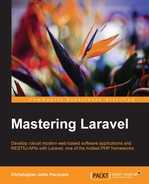PHP, a free and open source programming language, is continuing renaissance and Laravel is at the forefront. Laravel 5 is proving to be the most usable framework for novice and expert programmers alike. Following modern PHP's object-oriented best practices, reduce the time to market and build robust web and API-driven mobile applications that can be automatically tested and deployed.
You will learn how to rapidly develop software applications using the Laravel 5 PHP framework.
Chapter 1, Designing Done Right with phpspec, speaks about how to configure Laravel 5 for phpspec to perform modern unit testing, to use phpspec to design classes, and to perform unit and functional testing.
Chapter 2, Automating Tests – Migrating and Seeding Your Database, covers database migrations, the mechanics behind them and how to create a seed for testing.
Chapter 3, Building Services, Commands, and Events, talks about Model-View-Controller and how has evolved into services, commands, and events to decouple code and practice separation of concerns.
Chapter 4, Creating RESTful APIs, takes you through the creation of a RESTful API: the basic CRUD operations (create, read, update, and delete), as well as discussing some best practices and hypermedia controls (HATEOAS).
Chapter 5, Using the Form Builder, takes you to the web interface side of things and shows you how to take advantage of the some of the newest features of Laravel 5 to create web forms. Reversed routing will be discussed here as well.
Chapter 6, Taming Complexity with Annotations, focuses on annotations. The routes.php file easily becomes messy when an application grows in complexity. Using annotations inside of controllers, code legibility is drastically increased; however, there are some disadvantages in addition to the advantages.
Chapter 7, Filtering Requests with Middleware, shows you how to create reusable filters that can be called either before or after the controllers.
Chapter 8, Querying the Database with the Eloquent ORM, helps you learn how to use an ORM in a way to reduce the probability of errors in coding, increase the security and reduction of SQL-injection probability, and also learn how to deal with the limits of the Eloquent ORM.
Chapter 9, Scaling Laravel, speaks about scaling an application to move it into a cloud-based architecture. The read/write master/slave configuration is discussed and the reader is guided through the configuration.
Chapter 10, Building, Compiling, and Testing with Elixir, introduces Elixir. Elixir is based on gulp, which is a task runner and is a series of build scripts that automates common tasks in the Laravel software development workflow.
